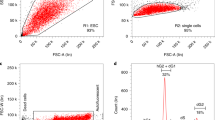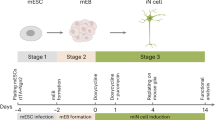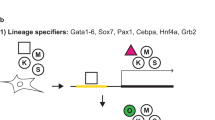Abstract
The derivation of induced pluripotent stem cells (iPSCs) usually involves the viral introduction of reprogramming factors into somatic cells. Here we used gene targeting to generate a mouse strain with a single copy of an inducible, polycistronic reprogramming cassette, allowing for the induction of pluripotency in various somatic cell types. As these 'reprogrammable mice' can be easily bred, they are a useful tool to study the mechanisms underlying cellular reprogramming.
This is a preview of subscription content, access via your institution
Access options
Subscribe to this journal
Receive 12 print issues and online access
$259.00 per year
only $21.58 per issue
Buy this article
- Purchase on Springer Link
- Instant access to full article PDF
Prices may be subject to local taxes which are calculated during checkout


Similar content being viewed by others
References
Takahashi, K. & Yamanaka, S. Cell 126, 663–676 (2006).
Brambrink, T. et al. Cell Stem Cell 2, 151–159 (2008).
Stadtfeld, M., Maherali, N., Breault, D.T. & Hochedlinger, K. Cell Stem Cell 2, 230–240 (2008).
Maherali, N. et al. Cell Stem Cell 3, 340–345 (2008).
Wernig, M. et al. Nat. Biotechnol. 26, 916–924 (2008).
Hockemeyer, D. et al. Cell Stem Cell 3, 346–353 (2008).
Sommer, C.A. et al. Stem Cells 27, 543–549 (2009).
Beard, C., Hochedlinger, K., Plath, K., Wutz, A. & Jaenisch, R. Genesis 44, 23–28 (2006).
Utikal, J. et al. Nature 460, 1145–1148 (2009).
Mikkelsen, T.S. et al. Nature 454, 49–55 (2008).
Sridharan, R. et al. Cell 136, 364–377 (2009).
Lengner, C.J. et al. Cell Stem Cell 1, 403–415 (2007).
Markoulaki, S. et al. Nat. Biotechnol. 27, 169–171 (2009).
Blelloch, R., Venere, M., Yen, J. & Ramalho-Santos, M. Cell Stem Cell 1, 245–247 (2007).
Eminli, S. et al. Nat. Genet. 41, 968–976 (2009).
Acknowledgements
We thank G. Mostoslavsky (Boston University School of Medicine) for the STEMCCA construct and secondary viral MEFs, A. Foudi and S. Eminli for help with hematopoietic cell isolation and culture, A. Khalil for help in cloning the Collagen-OKSM targeting construct, J. Polo for help with cell culture as well as for inspiring discussions, and C. Konrad for advice on tumor histology. M.S. was supported by a postdoctoral fellowship from the Schering Foundation, and K.H. was supported by a US National Institutes of Health Director's Innovator Award as well as by funds provided by the Harvard Stem Cell Institute and Massachusetts General Hospital.
Author information
Authors and Affiliations
Contributions
M.S. and K.H. conceived the study; N.M. performed blastocyst injections; M.S. performed all other experiments with help from M.B.; M.S. and K.H. analyzed the data and wrote the manuscript.
Corresponding author
Supplementary information
Supplementary Text and Figures
Supplementary Figures 1–7 (PDF 4928 kb)
Rights and permissions
About this article
Cite this article
Stadtfeld, M., Maherali, N., Borkent, M. et al. A reprogrammable mouse strain from gene-targeted embryonic stem cells. Nat Methods 7, 53–55 (2010). https://doi.org/10.1038/nmeth.1409
Received:
Accepted:
Published:
Issue Date:
DOI: https://doi.org/10.1038/nmeth.1409
This article is cited by
-
Integration-free induced pluripotent stem cells from three endangered Southeast Asian non-human primate species
Scientific Reports (2024)
-
H3K36 methylation maintains cell identity by regulating opposing lineage programmes
Nature Cell Biology (2023)
-
Dynamics of alternative splicing during somatic cell reprogramming reveals functions for RNA-binding proteins CPSF3, hnRNP UL1, and TIA1
Genome Biology (2021)
-
In vivo partial reprogramming of myofibers promotes muscle regeneration by remodeling the stem cell niche
Nature Communications (2021)
-
PANDORA-seq expands the repertoire of regulatory small RNAs by overcoming RNA modifications
Nature Cell Biology (2021)



